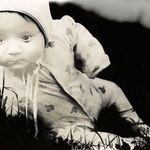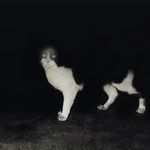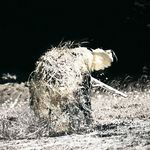Herman Pivk / Night at the window
HERMAN PIVK, Night at the Window
UGM | Maribor Art Gallery, Strossmayerjeva 6
opening: Friday, 12 July 2013 at 20:00
Herman Pivk is renowned as a fine art photographer. After the incipiently "clean" photographs at the beginning of his career, he took up photographs, which he has been developing since the mid-eighties by applying different creative techniques. This means he has digressed from classical photography and has been brought closer to the subjectivity and uniqueness of the medium of painting. His unusual visualisation of reality and authentic personal language incite a new way of looking at the photographic medium and means he occupies a special position among contemporary Slovene photographers.
In his first solo exhibition at Maribor Art Gallery, Herman Pivk displays his recent two series, which capture the period 2000 to 2013. In terms of content, the title Night at the Window refers to the linking of two series: HO-GARDEN and HOTEL BA-BO. HOTEL BA-BO was already presented at the Ljubljana City Art Museum in 2008, but is in the present exhibition put in a different relation. The title Night at the Window is a summary of two perspectives: one looks outwards through a window at the hotel garden, the other strolls through the rooms of BA-BO hotel. The window is the point of transition and contact, a margin that defines and separates the inside from the outside. The artist physically accentuated the notion of the window in the exhibition by wooden frames, which either suggest a look through the window or indicate the capture behind bars. In his working process, Herman Pivk derives from a rather randomly taken photograph, which by different interventions later on is submitted to transformation. His works wrench from the vice of reality so typical for photography, and reveal a different view. Besides, reality itself can seem obscure, abandoned or absurd, but the artist with his mysterious procedures liberates it of its documentary evidence bearing. In the works of Herman Pivk, the photographic image that is usually perceived as a confirmation of reality crosses the threshold that is defined by its own medium: it trespasses from the level of reality to the level of vision.
The artist's interventions into the photograph's positive in his earlier works (series Through the Mirror and Apprehending Nature) reveal his tendency to use several different procedures complemented by hand prints and similar things. These vigorous interventions introduce an inconceivable and often shuddering mystique by losing contact with the earthly world and approaching dream-like delusions. In his last series (HOTEL BA-BO, HO-GARDEN and H6), the artist interferes with the shot in a rather thoughtful manner and with mature restraint; the images are purified reaching outstanding visual qualities, and the technique of pigment print on canvas enables refined softness and outstandingly subtle transitions. His perspective is the view of a maverick who, with the same attention, halts at a grotesque of a human, the look of animal eyes or a water reflection. In the exhibition, the narration winds around images of animals, people, lost and forgotten objects, visions of domiciles, flashbacks and memory. A certain incision in the whole installation is maybe represented by the earlier series Through the Mirror (1987–2009), which the artist places into the centre of the narration. The works of Herman Pivk derive from this world, but gain their real likeness as late as on their way through the inner (subconscious) worlds that transform the initial reality in a mysterious way. In Pivk's works, black (with a few exceptions) is omnipresent, yet the central role in his works appertains to the light. The artist himself decides where in his works light will appear; he grants it the power to uncompromising unmasking and subtle elevation.
Animals as the artist's common motif represent an important part of the Night at the Window story. Hotel Garden (HO-GARDEN) − the garden (of the world) − without a human presence actually breathes much more freely. The human presence in this series is put entirely in the background; the human merely appears as a premonition or a menace. The pain, the craze and the isolation of the animal world are a result of the human being, and the artist very often exposes this universal relation towards animals. The plush on some of the works from the HO-GARDEN series is to be understood in this context as well. In contrast to this, the HOTEL BA-BO series looks inwards and even stronger than HO-GARDEN shows the other side: absurdity, being torn out of the whole (the creation) and loss of purpose. The human figures with their poise, placement into the space, meaningless pursuits and absurd venues accentuate hopelessness, isolation, withdrawal and a dead end, or anger and rage turning into violence. Individuals try painfully to escape from this situation or (rarely) enraptured – reach beyond it. Thus, the range of both series could be summed up as the world outside is still in place, the real drama happens not outside but inside and because (of us).
The language of Pivk's images is modern in terms of content and simultaneously archaic, in the sense of ancient. With its implementation, the artist expresses deep and ancient visions. The themes loneliness, isolation and alienation in his works do not only reflect time, but also carry the echo of the universal sojourning perception of the human race. Restlessness, questioning the meaning, doubt about the individual's role in society and the world, the weight of guilt and mistake are themes of humankind since antiquity that we have inherited. Pivk's figures reflect the whole tragedy of antique heroes: King Lear's despair, Jason's betrayal, Medea's madness, Odysseus' wandering etc. Inside of them, we sense the weight of the individuals who carry the awareness about the range of darkness and light inside. This is the foundation of Pivk's exceptional and unrepeatable portraits of Slovene visual, literary and dramatic artists.
Herman Pivk presents and exhibits his works in his very own manner. He does not lead the observer via the logic of a narrator, but creates by beading the images certain sensations and feelings. Fragments of images glint and step out of the darkness of the night before the spectator. Their instant, but light-exposed presence is as fragile as our own, which brings them closer to us than it seems at first sight. The intense images do not leave the observer unaffected; however, they do leave open space for individual reading.
Curator: Andreja Borin
Herman Pivk (Ljubljana, 1963) finished the Ljubljana High School for Design and Photography, Department of Graphic Arts. He studied at the Ljubljana Academy of Education and graduated in history and art teaching with the theme Portrait in Photography under Prof. Ivo Mršnik. He works as a freelance artist.
More about the artist and his work at: www.hermanpivk-foto.si


